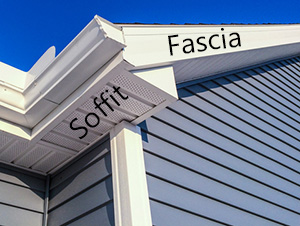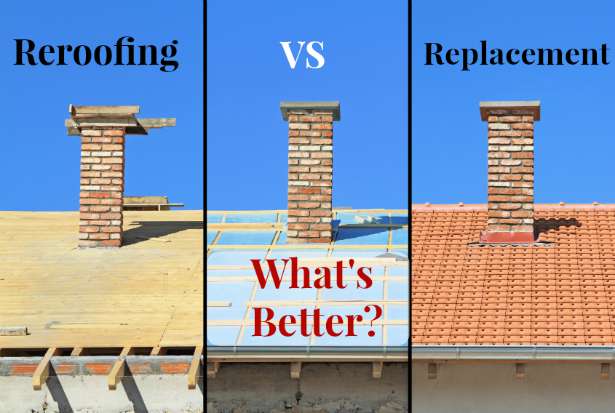Not all home improvement decisions are black and white.
For example, repairing a damaged roof can save time and money over replacing it, since repairs usually require less labor and materials.
On the other hand, reroofing (layering one set of new shingles over a set of existing shingles) might save you money today, but end up costing you more than a new roof in the long run.
How do you know if you should repair or replace? Let’s take a look.
Examining Your Roof Damage
To make an informed decision when it comes to reroofing vs. removing and replacing the old roof, you’ll need to assess the damage.
Don’t bother getting out the ladder—you can inspect the condition of your shingles at ground level. If you need, use binoculars to look for the signs that your roof is in need of repair or replacement. If you do decide to grab the ladder for your roof inspection, try not to walk on the shingles if you can avoid it—especially when the shingles are very hot or very cold. This can damage them even more.
Start by looking for signs of damaged shingles. Do you see shingles that are loose, cracked, rolling up at the edges or missing the granules on top? Do you see any places where shingles are missing completely?
Walk around your home, checking for pieces of the shingles (granules) that are pooling on the roof or that may have washed down your downspouts. Take note of the shingle condition around skylights, dormers, television antennas, satellite dishes and vent pipes.
If you have a chimney, look for cracked, damaged or missing bricks or stucco, and bent or torn flashing around the base. In addition to the roof, inspect under the eaves, overhangs and the fascia. Make sure the gutters aren’t rusty or otherwise damaged. Look at the metal flashing that surrounds roof vents, chimneys, skylights, and roof valleys to see if they are curled or missing.
Check the soffits under the roof for signs of leaks, and inside the house check the ceilings for brown spots on the ceiling, peeling paint underneath the overhang of the roof, and water stains on your pipes.
When Repair is the Best Option

Image courtesy of Hollywood Roofing
If you’re lucky, repairs may be all you need to extend the life of your roof. If a few shingles have been damaged by hail, wind, or the passage of time, repairing and replacing them may be all that’s needed. When the rest of the roof is fairly new and in good shape, patching can help save you a lot of money and extend the life of the roof.
However, if the roof is old and shingles come loose in the wind each time there’s a major storm, it might be time to reroof.
Warning: ugly patch jobs can detract from the curb appeal of your home (something to keep in mind if you’re selling). Try to find shingles that are a close match to what is already on the roof.
When Reroofing is the Best Option
Reroofing is the process of layering new shingles over old shingles. It can save homeowners money and trouble if their current roof isn’t in need of major repairs. A reputable roofing contractor will remove cap shingles and damaged shingles, then replace any missing shingles to ensure they have a level surface on which to install the new shingle layer.
The important thing to keep in mind is the quality of a reroofing job will depend on the roofing crew’s workmanship as well as the quality of the products used. Once the reroofing project is complete, it should offer the same protection as a new roof that is installed directly on a cleared deck.
Reroofing can only be done once, so if you already have two layers of roofing in place, reroofing is not an option for you. Even though universal building codes allow up to two layers of shingles on a roof, there are times it would be better to tear off the single layer and start fresh. For example, If you can see the underside of the shingles when you’re in the attic, you’ll need to tear everything off and install new plywood decking.
When Roof Replacement is the Best Option
As a rule of thumb, here at Statewide we tell homeowners that when more than 30 percent of the roof is damaged, a new roof is the best option. Also, if you roof is more than 15 years old, replacement may be the best course to take.
According to roofcostestimator.com, these are the average total costs of common roof systems for homes:
- 3-Tab Asphalt Shingles: $7,000 to $12,000
- 30-year Shingles: $9,000 to $15,000
- 50-year Shingles: $11,000 to $20,000
Remember, this is a national average—many of our clients in Wake County can get a new roof fully installed for under $10,000. Factors that can affect your cost include the brand and type of shingles, the type of underlayment and the slope of your roof.
According to the “Remodeling Impact Report” from the National Association of REALTORS®, homeowners can recover 109 percent of their investment in a new roof when they sell their home. The report also said homeowners gave their new roofing a “Joy Score” (how happy or satisfied they were with their remodeling project)
Roof Replacement in Raleigh and Wake County
Not sure if you should repair or replace your roof? As we’ve seen, it all depends on several factors, including the type of damage you have and what percentage of the total roof surface is in need of repair.
As Licensed General Contractors serving the Raleigh area, Statewide Construction LLC, can help you decide whether or not to replace or repair that damaged roof on your home and business. You can book a new roof consultation here—we’ll give you a quote that explains what’s needed and why.
main image courtesy of Northern Virginia Roofing
